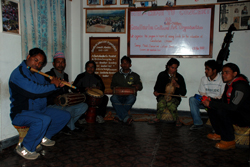The Gandharbas of Kathmandu
19 January, 2009, 02:57 am in "Nepal"
The Gandharba Culture and Arts Organization (GCAO) has a rather misleading sign that seems to point down the street when the office is actually in the alley under where the sign is placed. Fortunately, before we ended up on a fruitless search down the wrong street, a young man handed us a brochure advertising a free Nepali music concert. He led us through the alley up a dark stairway apologizing for the lack of electricity-- a fact of life in Nepal due to the “Load shedding” power cuts.
There was still a little light coming through the window into the small room where a group of young men sat with drums, sarangi (Nepali carved wooden violin) and flutes. As we walked in and sat down they leaped into action and began playing.
It was a casual setting and quite enjoyable. They sang as well. Sometimes one would get up and dance. Little by little, more musicians filtered in, many carrying sarangis. Eventually there were about 20 musicians in the small room as well as a couple more tourists who stopped by for a bit.
Many of the musicians we recognized as sarangi sellers who frequent the Thamel streets. This is part of a program of the GCAO to improve music instrument business for their members.
The music is bright and cheerful and reminiscent a little of bluegrass and Celtic music. The concert went on for about 1 hour (˝ hour for each group of tourists).
The goal was to get support for their organization through CD purchases and donations as well as share their music. Their nightly concerts are a welcome escape from the western rock music blasting from Thamel clubs.
All the performers are from the Gandharba or gaine caste. They were considered an “untouchable” caste and were made up of musicians and performers. In addition to performing, the Gandharbas were the carriers of news and gossip through the distant villages. Although Nepal banned discrimination based on caste, the Gandharbas still suffer the effects from their forced low position in society, as well as from their livelihood being replaced by modern media.
The GCAO seeks to “keep the Gandharba traditions alive and improve their economic status”. They do this through improving education for the Gandharba people, increasing economic opportunities, motivating the Gandharba who are oppressed and destitute to live with self respect and dignity, and raising public awareness. They also work in support of the other “untouchable” (Dalit) castes.
If in Thamel, Kathmandu, stop by between 5PM and 7PM for the cultural program. If outside of Kathmandu, visit their website GCAO
There was still a little light coming through the window into the small room where a group of young men sat with drums, sarangi (Nepali carved wooden violin) and flutes. As we walked in and sat down they leaped into action and began playing.
It was a casual setting and quite enjoyable. They sang as well. Sometimes one would get up and dance. Little by little, more musicians filtered in, many carrying sarangis. Eventually there were about 20 musicians in the small room as well as a couple more tourists who stopped by for a bit.
Many of the musicians we recognized as sarangi sellers who frequent the Thamel streets. This is part of a program of the GCAO to improve music instrument business for their members.
The music is bright and cheerful and reminiscent a little of bluegrass and Celtic music. The concert went on for about 1 hour (˝ hour for each group of tourists).
The goal was to get support for their organization through CD purchases and donations as well as share their music. Their nightly concerts are a welcome escape from the western rock music blasting from Thamel clubs.
All the performers are from the Gandharba or gaine caste. They were considered an “untouchable” caste and were made up of musicians and performers. In addition to performing, the Gandharbas were the carriers of news and gossip through the distant villages. Although Nepal banned discrimination based on caste, the Gandharbas still suffer the effects from their forced low position in society, as well as from their livelihood being replaced by modern media.
The GCAO seeks to “keep the Gandharba traditions alive and improve their economic status”. They do this through improving education for the Gandharba people, increasing economic opportunities, motivating the Gandharba who are oppressed and destitute to live with self respect and dignity, and raising public awareness. They also work in support of the other “untouchable” (Dalit) castes.
If in Thamel, Kathmandu, stop by between 5PM and 7PM for the cultural program. If outside of Kathmandu, visit their website GCAO
Comments
- Comments
Powered by My Blog 1.69. Copyright 2003-2006 FuzzyMonkey.net.
Created by the scripting wizards at FuzzyMonkey.net..
(Code modified by Rowshan Dowlatabadi)
Created by the scripting wizards at FuzzyMonkey.net..
(Code modified by Rowshan Dowlatabadi)


